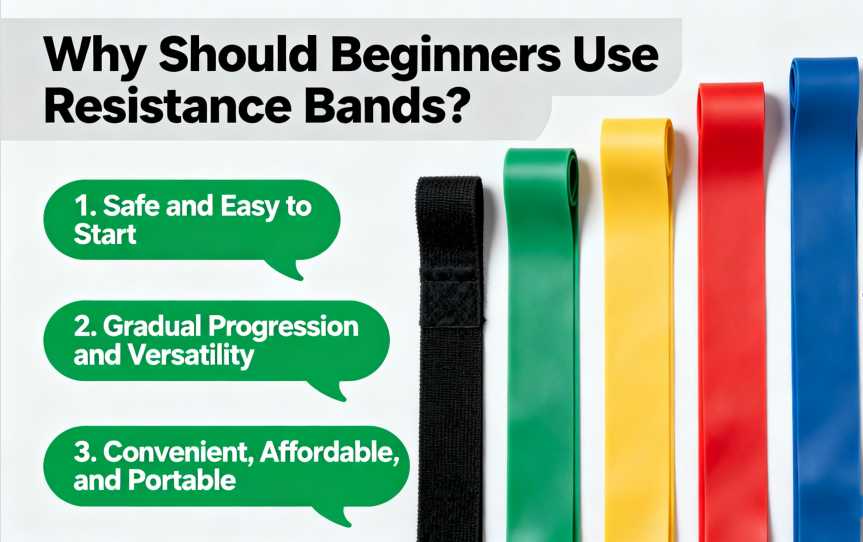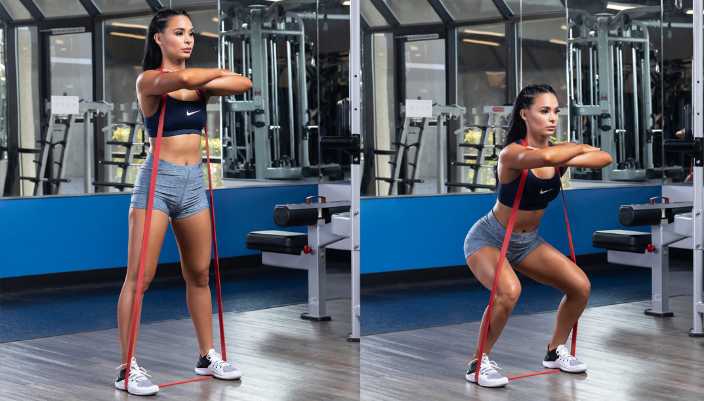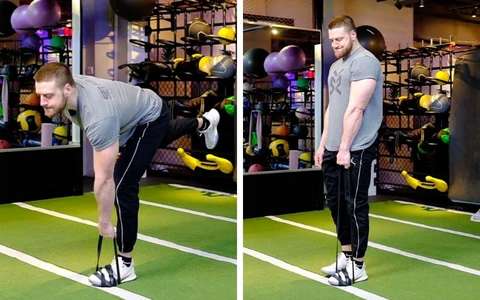Resistance bands are one of the most flexible and easy-to-use fitness tools. Whether your goal is to build strength, improve flexibility, or tone your muscles, resistance bands make it easy to stay fit anywhere—like at home, in a park, or while traveling.
✅ Why Should Beginners Use Resistance Bands?
Resistance bands are the best choice for beginners because they are safe, help you progress over time, and fit easily into your lifestyle. They help new exercisers gain confidence, build strength, and develop a routine that sticks.
1. Safe and Easy to Start
Resistance bands are one of the safest tools for beginners because they don't put as much stress on your joints and muscles as heavy weights. The tension is smooth and adjustable, helping new users focus on proper form and posture without risking injury. This makes them perfect for people who are just starting out or returning to exercise after a long break.
2. Gradual Progression and Versatility
Beginners can easily control the difficulty by choosing different band resistances—light, medium, or heavy. As they get stronger, they can switch to thicker bands for more challenge. Resistance bands can be used for a variety of exercises, from building strength and tone to stretching and rehab. They can target all major muscle groups—arms, chest, back, core, and legs—using just one piece of equipment.

3. Convenient, Affordable, and Portable
Unlike traditional gym equipment, resistance bands are light, compact, and inexpensive. Beginners can use them anywhere—like at home, the gym, or while traveling. This makes it easier to build a daily workout habit without worrying about space or cost.
✅ 5 Resistance Band Exercises for Beginners
Resistance bands are an easy and effective way for beginners to build strength, improve flexibility, and tone muscles. These 5 exercises provide a full-body workout that's easy to do at home or anywhere. They help beginners get started safely and effectively.
1. Banded Front Squat
How to do it: Stand on the band with your feet shoulder-width apart. Hold the handles or ends of the band at shoulder height. Squat down by pushing your hips back and bending your knees, then return to standing.
Benefits: Strengthens quads, glutes, and core while improving balance.
Tip: Keep your chest up and knees aligned with your toes to prevent strain.


2. Bicep Curl
How to do it: Stand on the band with your feet hip-width apart. Hold the ends of the band with palms facing forward. Curl your arms up toward your shoulders, keeping your elbows close to your body, then slowly lower back down.
Benefits: Builds arm strength and tones the biceps.
Tip: Avoid swinging your arms; move slowly for maximum tension.
3. Seated Row
How to do it: Sit on the floor with your legs extended. Loop the band around your feet and hold the ends with both hands. Pull the band toward your torso, squeezing your shoulder blades together, then slowly release.
Benefits: Strengthens back, shoulders, and improves posture.
Tip: Keep your back straight and avoid leaning backward.


4. Kickstand Single-Leg Romanian Deadlift
How to do it: Stand on one leg with the band under that foot. Hold the other end with both hands. Hinge at your hips, lowering the band toward the ground while extending the free leg behind you, then return to standing.
Benefits: Improves balance, strengthens hamstrings, glutes, and core.
Tip: Keep a slight bend in the standing knee and move slowly to maintain stability.
5. Abduction
How to do it: Loop the band around both legs just above your knees. Stand with feet hip-width apart and lift one leg out to the side, keeping it straight, then return. Repeat on the other leg.
Benefits: Strengthens glutes, hips, and outer thighs.
Tip: Keep your core engaged and avoid leaning to the opposite side.

We are committed to delivering exceptional support and
top-tier service whenever you need it!
✅ A Balanced Resistance Band Workout Plan for Beginners
For beginners, creating a structured resistance band workout plan helps build strength, improve mobility, and develop a consistent routine. Here's a simple 5-day plan that allows for gradual progress while giving your muscles time to recover:
Day 1: Upper Body
Focus on the chest, back, shoulders, and arms using resistance bands.
Exercises can include:
• Bicep Curls – 2–3 sets of 12–15 reps
• Seated Rows – 2–3 sets of 12–15 reps
• Shoulder Press – 2–3 sets of 10–12 reps
• Tricep Extensions – 2–3 sets of 12–15 reps
This session strengthens upper-body muscles while teaching beginners proper form and control with resistance bands.
Day 2: Lower Body
Target the legs and glutes to build foundational lower-body strength.
Exercises can include:
• Banded Front Squats – 2–3 sets of 12–15 reps
• Kickstand Single-Leg Romanian Deadlifts – 2 sets of 10–12 reps per leg
• Glute Bridges with Band – 2–3 sets of 12–15 reps
• Abductions – 2 sets of 15 reps per leg
These movements improve stability, balance, and muscle endurance in the lower body.
Day 3: Rest or Active Recovery
Rest is important for muscle recovery and growth. Beginners can do light stretching, yoga, or a short walk to stay active without overloading their muscles.
Day 4: Cardio and Core
Combine resistance band exercises with cardio to improve endurance and strengthen the core:
• Standing Side Steps with Band – 2–3 sets of 15 steps each direction
• Russian Twists with Band – 2–3 sets of 15–20 reps
• Bicycle Crunches – 2–3 sets of 15–20 reps
• Mountain Climbers – 2 sets of 30–45 seconds
This day improves heart health while targeting core stability and overall coordination.
Day 5: Rest or Light Activity
Another rest day allows muscles to recover. Gentle activities like walking, stretching, or foam rolling can help relieve tension and improve flexibility.
✅ Conclusion
Getting started with resistance band exercises is an easy and effective way for beginners to improve strength, mobility, and overall fitness. With just a few bands and a consistent routine, you can enjoy a full-body workout anytime, anywhere, building confidence and achieving your fitness goals without the need for heavy equipment or a gym membership.

Talk To Our Experts
Connect with an NQ expert to discuss your product needs
and get started on your project.
✅ FAQs About Resistance Bands
1. What are the benefits of using resistance bands for beginners?
Resistance bands provide a low-impact, versatile way to build strength, improve flexibility, and tone muscles. They are safer for joints than heavy weights, allow for controlled movements, and can target all major muscle groups. Beginners can start with lighter bands and gradually increase resistance as they get stronger.
2. What types of exercises can you do with resistance bands?
Resistance bands can be used for a wide range of exercises, including squats, bicep curls, rows, glute bridges, abductions, and core twists. They can also be incorporated into cardio routines, stretches, and rehabilitation exercises, making them extremely versatile for a full-body workout.
3. How do you choose the right resistance band for beginners?
Start with light or medium resistance bands to learn proper form and prevent injury. Bands are often color-coded by resistance level, so you can gradually progress to heavier bands as your strength improves. Having a few different resistance levels allows you to adjust intensity for different exercises.
4. Can resistance bands help with weight loss or fat burning?
Yes. While resistance bands primarily build strength and tone muscles, they can also support fat loss when combined with cardio and a healthy diet. Performing high-repetition resistance exercises or incorporating them into circuit-style workouts can increase calorie burn and improve overall fitness.
5. Are resistance bands suitable for people with injuries or limited mobility?
Yes. Resistance bands are gentle on joints and allow controlled, low-impact movements, making them suitable for rehabilitation, injury recovery, or for individuals with limited mobility. Always consult a healthcare professional if you have a specific medical condition before starting a new exercise routine.
Post time: Oct-31-2025
